Ordinarily we could say that February 8th marks the beginning of the second quarter for this particularly-shaped month, but we’re in one of those years with an extra day.
How are your plans to mark Leap Year shaping up? Would you support an alternate plan to make that extra rotation its own special month, and if so, what would it be called? This assemblage of information is called Charlottesville Community Engagement and I’m called Sean Tubbs, and this is called the last sentence of the intro.
On today’s show:
City Council holds the second reading on a resolution authorizing the purchase of 405 Levy Avenue from the Charlottesville Redevelopment and Housing Authority and the amount authorized increased since the first reading
The General Assembly catch-up session continues with a list of continued bills
The Board of Architectural Review takes a look at a speculative project on West Main Street on property that has since been listed for sale
First shout out: RCA holding open house on February 15
In today’s first Patreon-fueled shout-out: Are you interested in learning more about the health of area waterways? Want to get some first-hand experience using science to evaluate water quality? Or perhaps you’d like to help keep rivers and streams clear of debris and trash?
If so, consider joining the Rivanna Conservation Alliance for a volunteer open house on Thursday, February 15th. Come by the RCA office on River Road anytime between 4 p.m. and 7 p.m. to learn about their programs and the many ways you can get involved. Staff members will be on hand to share information about their monitoring, restoration, education, and stewardship activities. New and current volunteers are welcome! Light refreshments will be provided. RSVPs are appreciated at rivannariver.org.
Council approves Charlottesville’s purchase of CRHA property on Avon Street
The Charlottesville City Council has authorized Sam Sanders to spend up to $4.181 million to purchase two properties from the Charlottesville Redevelopment and Housing Authority. The funding comes from the American Rescue Plan Act but no final decision has been made about whether the property will be used as a homeless shelter.
“It’s a real estate transaction,” said Charlottesville Mayor Juandiego Wade. “There’s been no determination at this point as to what’s going to be done with it. I know what’s out there.”
The topic was first raised by City Manager Sam Sanders at the Planning Commission’s January 9, 2024 meeting when he was asked what was planned for addressing calls for a permanent shelter.
“I had a question on the things up for discussion, the homelessness strategy, do we have any ballpark cost numbers?” asked Planning Commissioner Karim Habbab.
In response, Sanders told Habbab that there was no specific strategy or cost associated with it yet, but he had a small preview of an item that would come up at Council’s January 22 meeting, one that had been postponed by inclement weather.
“Not to get ahead of Council, but I’m sharing something with them this week for action that we might able to take to move this particular initiative forward but there’s a lot to be determined in what is the right approach,” Sanders said.
Here’s how the staff report for the January 22 meeting reads:
“This acquisition supports the City Manager's commitment to homelessness intervention as it could become the site of a facility that serves to meet that need among others,” reads the report. “The intention is to hold the property until a comprehensive assessment of homeless service needs - including shelter beds -is completed, along with a feasibility study to operate 24/7, 365 days a year.”

The second reading on the matter was on the consent agenda. Between the two readings, the total amount of ARPA funding to reallocate toward the project had increased to $4,181,000.
Members of the public are given the opportunity to comment on consent agenda items before one vote is taken to approve them all.
Nearby resident Alex Ommaya expressed concern that the site had been a gas station for many years before being purchased by the CRHA and that there had been previously been a petroleum leak from a tank when the property had the business of Kenny and Jeff’s Auto Repair.
“In terms of fully understanding what you’re getting into, I think it’s important to populate the environmental issues associated with the site,” Ommaya said.
Ommaya also called on the city to engage with city residents who he said were not consulted before Council selected a potential location for a future homeless shelter. He said if the city proceeds with this site as a place for a permanent shelter, services would be needed to support residents and that cost would need to be covered.
“I think budget should be considered and evaluated for support of those services because if you don’t provide the full suite of services, the problems of the residents become city residents basically and we want to make sure they are adequately addressed,” Ommaya said.
Ommaya had been the first speaker, and Mayor Wade made his comments before the second speaker. He said a final decision on what to do with the property would come after the comprehensive study has been completed.
“What does this community need? What is the real need, the number of beds that is needed?” Wade asked. “We don’t know that yet and once we have that information we will then work with the community, our partners, to determine what that would look like.”
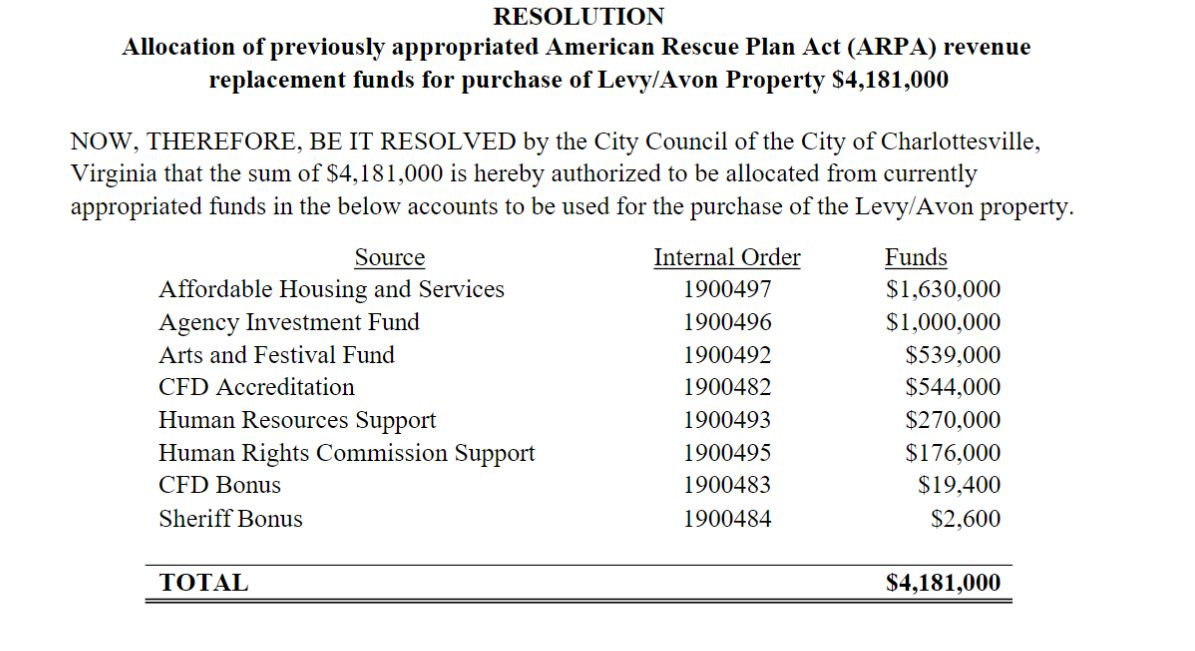
The consent agenda gave the opportunity for people to offer their thoughts on the purchase and several other people spoke on this topic.
Rebecca Ellison is an adjacent resident on Hinton Avenue who expressed support for the city purchasing the lot for the stated purpose.
“While I understand that shelter services are necessary at times, I hope the redevelopment plans also include deeply affordable housing and permanent supportive housing units for those who may not be able to meet the requirements of a residential shelter while they stabilize and move towards permanent housing,”
Catherine Walden is also an adjacent resident on Hinton Avenue and also supported the city purchasing the land to provide services and that could be an asset.
“But, and you have said you will do this, I want to hold you all to the promise that you will conduct robust community engagement for this process,” Walden said. “It’s a big site. People walk past it every day. School kids get off the bus and walk down to Kindlewood right by it. There’s a lot going on at that site and there’s a lot of potential so I’m going to hold you to your promise.”
Walden also suggested other properties may be more suitable for the purposes of a homeless shelter.
“A shelter has an element of danger, of uncertainty, potentially with it that can be extremely disruptive for any residential neighborhood, not just this particular one,” Walden said.
Walden suggested the city instead consider purchasing 310 West Main Street, the former location of the Greyhound Bus station that was purchased in January 2023 for over $2.42 million and is currently on the market.
Assuming the purchase price will be the full amount Council authorized, the city would purchase the land from the CRHA for 52.62 percent above the assessed value.
When asked about this at Council’s meeting on January 22, Sanders responded that a sustainability study commissioned by CRHA estimated that CRHA could have gotten between $7 million and $11 million on a sale to the private market.
“I’ll add that there are additional community benefits that will come later as CRHA unveils what they would do with the resources that they will receive for this site,” Sanders said at the time. “It checks additional boxes to benefit the city and its economic development strategies.”
On January 26, the CRHA Board of Commissioners, which includes City Councilor Michael Payne, voted to authorize executive director John Sales to purchase 310 East Main Street for up to $2.65 million for a future headquarters and other uses.
The city’s purchase reflects a city government willing to spend money to obtain land and property. In the past year, Charlottesville has:
Spent $5.9 million to purchase nearly 24 acres of land on the Rivanna River
Contributed $5 million to the CRHA for half the cost of purchasing 74 units known as Dogwood Housing from Woodard Properties
The School Board purchased Albemarle’s share of the Charlottesville Area Technical Education Center for $5.3 million
General Assembly update: Sales tax bill still alive; Legislation to expand photo-speed cameras continued until 2025
We’re now past the halfway mark for the 2024 General Assembly, an annual frenzy where hundreds of bills are processed within a brief period of time. What started four weeks ago today will be complete on March 9 when both Houses adjourn for six weeks while Governor Youngkin decides what he’ll sign and what he will veto.
Perhaps one of the most important bills for localities across Virginia is one that would allow any locality across Virginia to hold a referendum to ask voters if they would consent to a sales tax increase to fund schools. Several jurisdictions across Virginia have this authority due to specific requests that were approved when Democrats held both chambers , such as Danville.
After the Republicans regained the House of Delegates in time for the 2022 session, a bill to allow Charlottesville the ability to hold a referendum died in a subcommittee. Go back and read the story.
A bill from Senator Jeremy McPike (D-29) would give blanket permission to all localities to put the question to the public. SB14 reported out of the Senate Finance and Appropriations Committee on a 10 to 4 vote and passed the Senate on a 27 to 13 vote.
Now on to legislation that has been continued on to the next session.
HB20 would have allowed localities to place photo-speed cameras in any location rather than just in school zones and highway work zones. A House of Delegates transportation subcommittee has continued this legislation until the 2025 session.
A similar bill, HB521, was incorporated into HB20 and is also thus continued until 2025.
HB33 would have directed the Commissioner of Health to convene a work group to study microplastics in drinking water and made recommendations. A panel of the Rules Committee continued the bill to 2025 on a voice vote.
HB41 would have required the Board of Education to create a Standard of Learning for civics and local government. The K-12 subcommittee held a voice vote.
HB228 would have amended the Virginia Consumer Protection Act to prevent the sale of sale of containers or packaging that is labeled as recycling unless the material is officially recognized by the Virginia Waste Management Board.
HB524 would have required applicants for federal permits for natural gas lines with a diameter of 24 inches to also file with the Virginia Department of Environmental Quality. Currently the DEQ does review permits greater than 36 inches in diameter.
HB658 would expand ranked choice voting to any elected office in a locality, not just a City Council or a Board of Supervisors. Also continued to 2025.
HB747 would have created standards for developers of “artificial intelligence.” A substitute was developed, but that’s been continued to 2025.
HB900 would have required a locality to include in its zoning ordinance a provision for allowing accessory dwelling units in single-family residential zones. This was continued through action in the Counties, Cities, and Towns Committee.
HB922 would have allowed “common interest communities” such as homeowners’ associations to ban the use of pesticides.
HB961 would have established a tax credit program for the sustainability of local newspapers. Fun fact: I looked this up on news.google.com and there were no hits. Maybe in 2025?
HB1091 would have required the Virginia Advisory Committee for Career and Technical Education to recommend best practices for introducing career and technical education into elementary school.
HJ24 would have created a 13-member joint subcommittee to study the Dillon Rule and its impact on Virginia localities. Maybe again in 2025.
SB124 would have allowed betting on sports played by Virginia college and university teams. This reported out of the General Laws and Technology on a 12 to 2 vote but the Finance and Appropriations Committee continued the bill to 2025.
More from Richmond in the next edition.
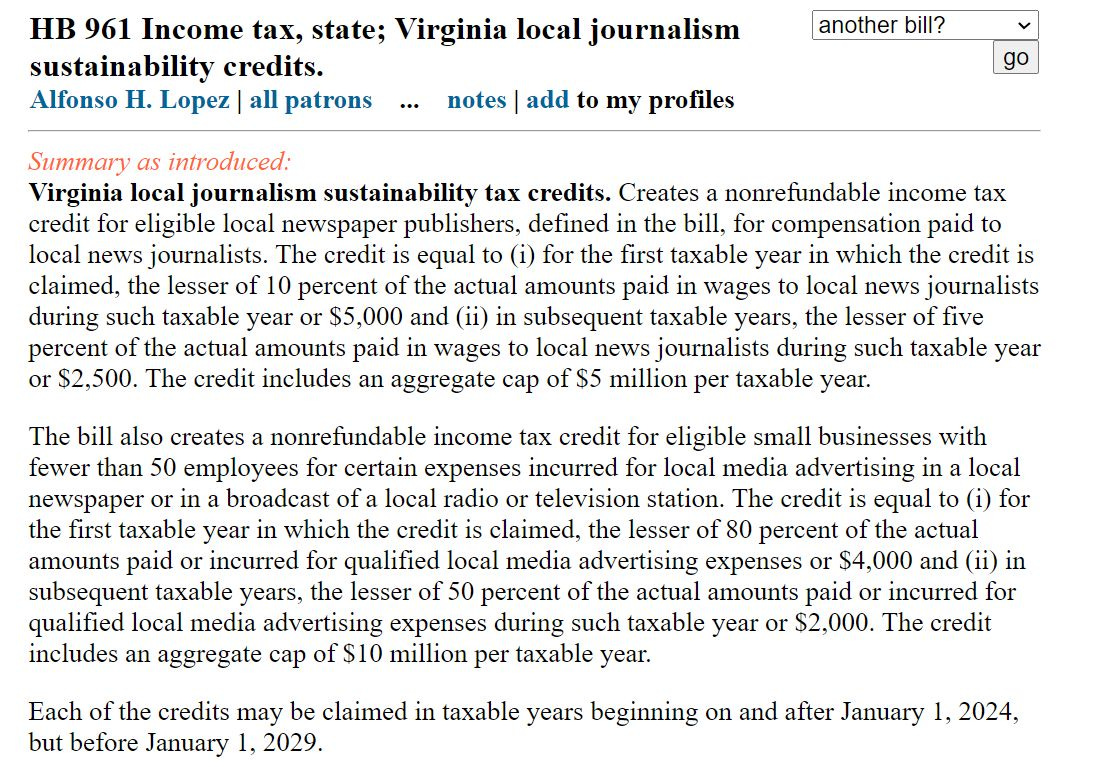
Second shout out: ACHS shout-out for upcoming programs
February’s a busy month for the Albemarle Charlottesville Historical Society with four events for you to consider.
On February 13, 2024, architectural historian Richard Guy Wilson will give a presentation on the Colonial Revival style that is commonplace in Charlottesville and Williamsburg. This talk will be at the Center at Belvedere at 6 p.m. This even is sold out, but you can stream it via Facebook Live.
On February 14, 2024, JMRL’s Historical Collection Librarian will give an introduction to African American genealogy at 11 a.m. for those who want to find their ancestors.
On February 20, 2024, Preservation Piedmont, JMRL, and the ACHS will present a free screening of the documentary Raised / Razed at 6 p.m. in the Swanson Room at the Central Branch. (rsvp)
On February 25, 2024, ACHS is sponsoring the film premier for CURRENT: A Descendant’s Journey for Truth at the Lighthouse Studio Theatre. At a time of significant pushback on the teaching of "whole truth" history in our schools and book banning throughout the country, this timely film explores the question: Why is it important to tell the truth about history? Tickets are available for sale here.
For more information about the Albemarle Charlottesville Historical Society, visit https://albemarlehistory.org/
Review of speculative project on West Main Street gives hint at future process
The owner of a property that includes Mel’s Diner on West Main Street has put the site up for sale with an asking price of $7.8 million. The February 1 listing came just two weeks after the Board of Architectural Review held a preliminary discussion about the future of two buildings that require their permission to be demolished.
“This is very much a work in progress by the way but this is the beginning of the shape it might take,” said Kevin Riddle with the firm Mitchell Matthews Architects and Planners.
Riddle and his firm did not represent a particular owner according to Jeffrey Werner, the city’s historic preservation planner, but the presentation on January 17 offered a glimpse into the role the Board of Architectural Review may play under the new Development Code.
As of mid-January, Werner said staff were trying to understand all of the new parameters of the new Development Code, and he had not conducted any sort of analysis of what the new Corridor Mixed Use 5 zoning might mean.
“What’s in front of you is sort of aspirational and it’s not something that I can say oh, yes, everything here is fine except for the design review,” Werner said.
In all there are three pieces of property listed totaling 0.608 acres with a combined 2024 assessment of over $3.1 million. Two of the parcels are in the West Main Architectural Design Control District and another on Cream Street is outside of that boundary.
The materials were not presented to the appointed body until the meeting.
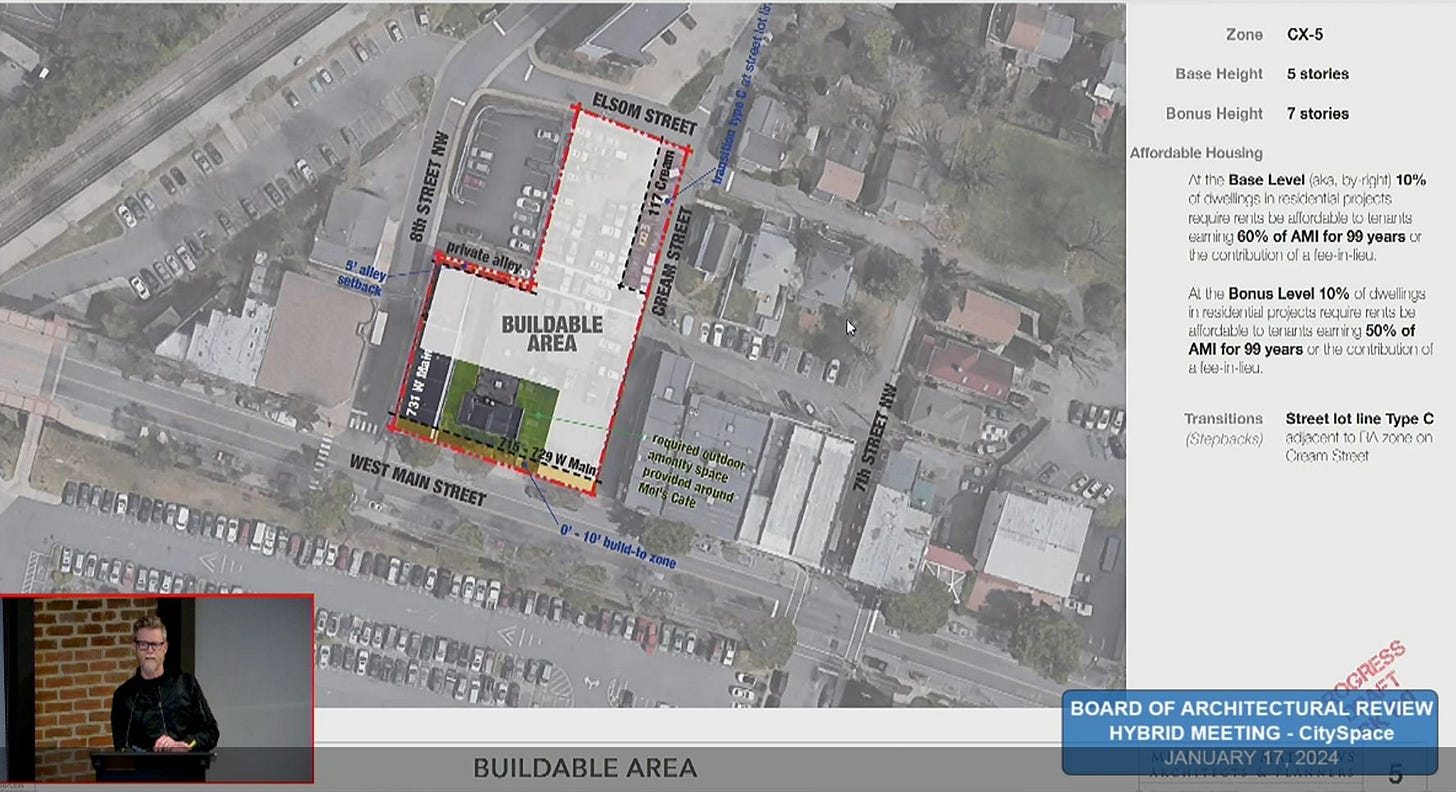
Werner advised the BAR to ask about the fate of the two contributing structures, which require permission from a legislative body in order to be demolished. City Council agreed in December 2013 to protect more buildings as I wrote about at the time for Charlottesville Tomorrow.
“The Mel’s Diner is a 1960’s building,” Werner said. “It was added as a contributing structure in 2014. The map was updated. It involves the entire building. Curiously, this was not originally a diner but was a dry cleaners and the back single story building was the machine works of the dry cleaners.”
Werner said the building that houses Mel’s is an iconic one important to the community.
“If nothing else, the front of the building with the strange roof is really a piece that I think a lot of people would fight to preserve,” Werner said.
The properties are now zoned CX-5, which means new development could cover the entire lot, though 10 percent must be set aside for “outdoor amenity use.” Allowed heights in CX-5 are 72 feet as a by-right base with 100 feet if affordable units are designated.
“The site is zoned with our new zoning at CX-5,” Riddle said. “There are properties across from it, across from Cream Street that are [Residential-A] and so that will impose a transition zone on a part of this property.”
Riddle said that would require a stepback in height to limit encroachment on the smaller structures in the R-A zoned land.
“And so you can go up to three stories and then you have to build 20 feet in and add stories above that,” Riddle said.
Riddle said their speculative proposal was for seven stories, which would require compliance with the city’s new affordability requirements. He said the project’s full scope was still being worked out and no developer was mentioned during the presentation.
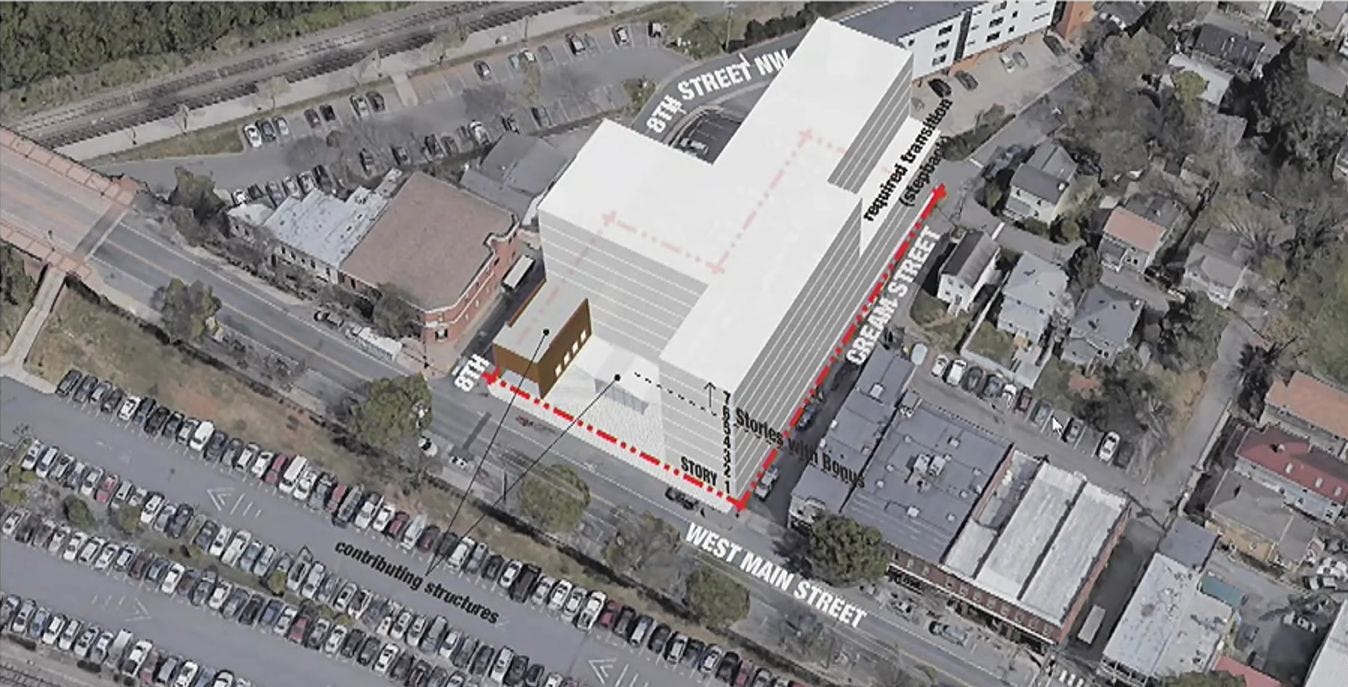
One of the first images Riddle showed was an overview of where the buildable area would be for the site with the preservation of at least the front portion of the Mel’s Building as well as 731 West Main Street.
“We’re asking to what extent might these contributing structures kind of adapt to a newer building,” Riddle said. “To what extent could they accommodate a new building and might there be partial demolition to make way for it?”
When it was time to ask questions or make comments, one got right to that question.
“Is it the idea and the intent that if we retained Mel’s that it would continue to be a restaurant space?” asked BAR Chair James Zehmer.
Zehmer wanted to know if the kitchen was in the portion of the site indicated in the presentation to be demolished.
“We haven’t been in there to really measure it and confirm but it does not extend much at all,” Riddle said. “In fact, most of the rear portion is basically an auto-repair shop right now.”
Zehmer said he would be opposed to the front portion where Mel’s is, but he would be open to supporting the demolition of the back portion.
“Similarly with 731 West Main, I went and took a look today and it’s clear where the 1930’s addition is because there’s a cold joint in the masonry,” Zehmer said, suggesting the front portion of that building should be preserved as well.
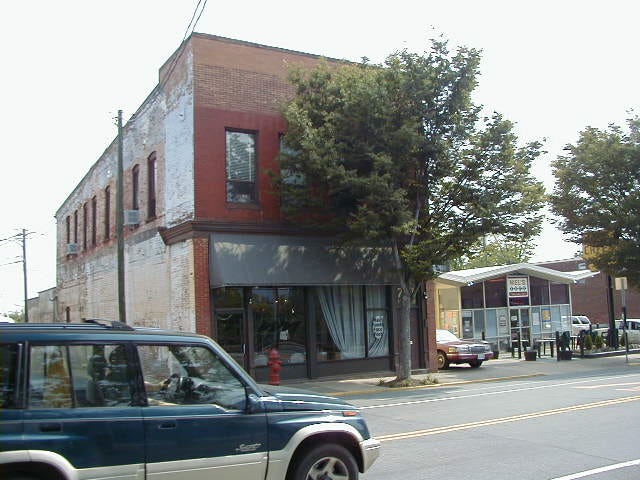
Another BAR member thanked Riddle for bringing forth a project that would preserve the contributing structures. BAR member Breck Gastinger agreed and cited a couple of precedents.
“Both the Quirk and SIX HUNDRED WEST MAIN are other good example of similar strategy that worked,” Gastinger said.
Gastinger said the massing and scale would have a large impact on Elsom Street, but acknowledged that was beyond the scope of the BAR.
Carl Schwarz is the Planning Commission’s representative on the BAR and a resident of the 10th and Page neighborhood. He suggested that any design should preserve the entire portion of 731 West Main that has two stories.
“There are some interesting vestige signs still on that wall that I would hate to see you guys white wash it or cover it up,” Schwarz said.
Schwarz was also interested in finding out how the streetscape standards called for in the Development Code would affect the design on Cream Street.
“Cream Street is a major pedestrian route,” Schwarz said. “Most people coming up from my neighborhood don’t come up 8th Street to West Main, they actually kind of cut around this parcel and come through the Cream Street alleyway.”
Riddle said they would be trying to find space to accommodate what the streetscape standards describe as Mixed Use B, but said there could be a challenge finding enough room.
“But, I hear you and especially on Cream Street we recognize it would be important to not leave only blacktop between a new building and an existing one on the other side of the street,” Riddle said.

This was a preliminary discussion which means no proposal has been submitted. No matter what comes back to the BAR in the future for a Certificate of Appropriateness, one member described what he wants to see.
“I want a building that is clean, modern, and preserves the historic structures as part of that and I think that this direction is probably the right direction to go in my opinion at this point,” said BAR member Ron Bailey.
Another BAR member urged do what’s possible to keep Mel’s on the site after redevelopment, as what happened with Blue Moon Diner at 600 West Main Street.
“I think it’s been around since the 90’s, the business itself, and just being respectful of trying to have this project kind of work around and not run that business off is an important thing for the community.” said BAR member Tyler Whitney.
What will happen? Stay tuned to my property transactions and my articles in C-Ville Weekly to see what does happen when it happens. .
Reading material:
Automotive zone: Equipment rental company buys the old Phillips Supply building on Rio Road, Sean Tubbs, C-Ville Weekly, February 7, 2024
Coalition hopes lawmakers increase ‘remarkably uncompetitive’ teacher wages, Heather Michon, Fluvanna Review, February 8, 2024
Aqua rate increase unjust, too high, report finds, Heather Michon, Fluvanna Review, February 8, 2024
Declining mortgage rates means Charlottesville house sales should tick back up, Emily Hemphill, Charlottesville Daily Progress (paywall), February 8, 2024
#634 is finite, finished, finalized, free!
This may be the first edition of the newsletter that has one segment that has soundbites from three separate meetings. When I tell people who pay for a subscription that they’re paying to keep me paying attention, that’s what I mean. I try to bring in as much information as I can and detest when I do not have all I need to know to bring you accurate stories.
To what end? Sometimes I’m not sure, but this is the work I was drawn to do over 30 years ago, and I’m devoted to continuing to do it as this 21st century continues as a period of rapid change with decreasing community context. I want to change that, and thank you to the paid subscribers who make that happen.
If you would like to join them, I remind you or tell you for the first time that Ting will match your initial subscription through Substack.
And maybe you’re in the market for new Internet? Check out Ting to see what they have to offer, and if you decide to proceed, enter in the promo code COMMUNITY to receive:
Free installation
A second month for free
A $75 gift card to the Downtown Mall






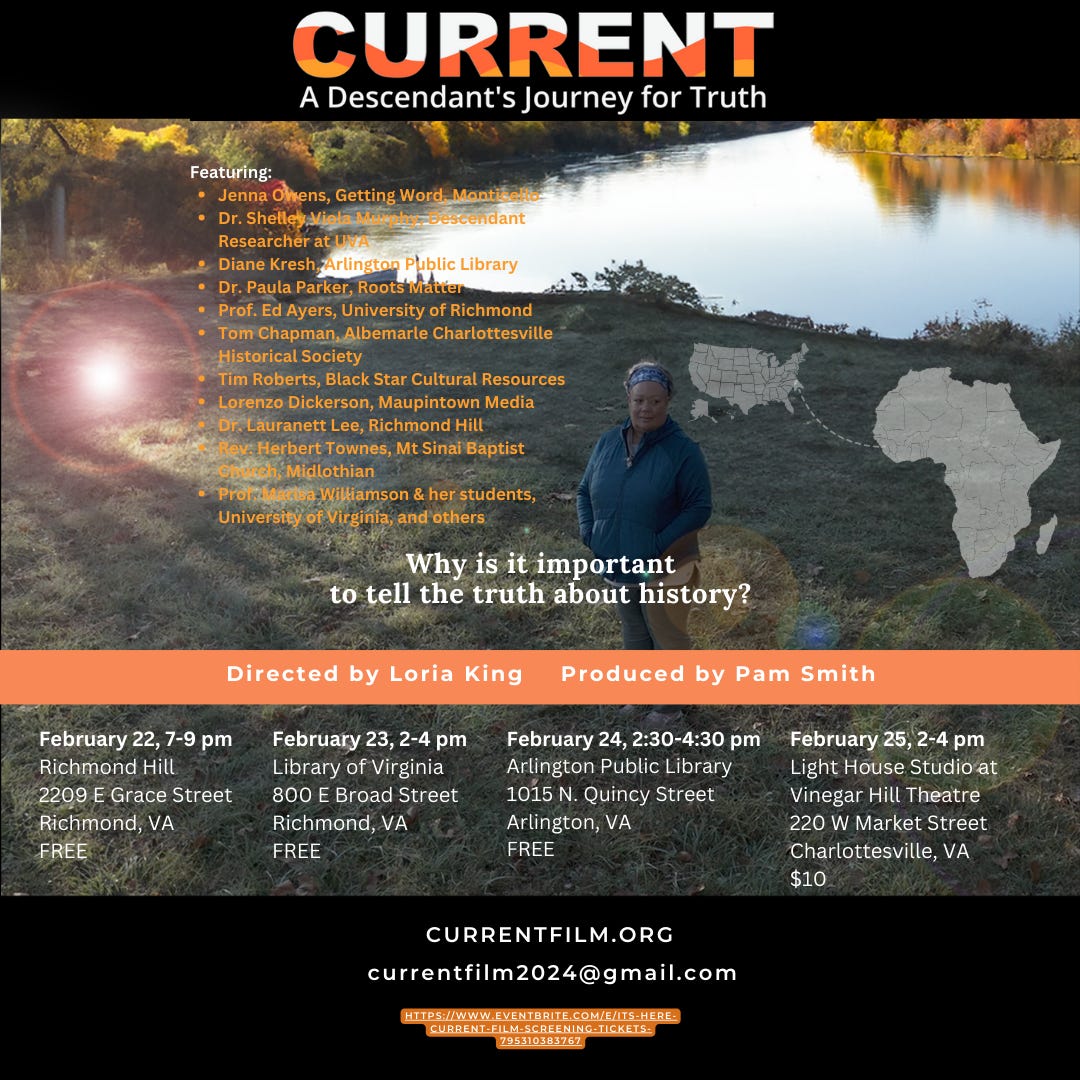









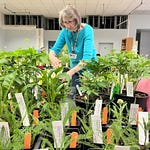
Share this post